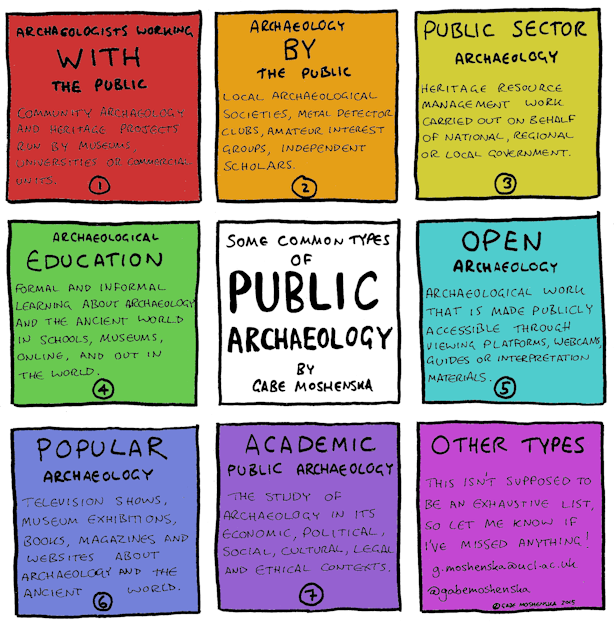
Our aim in this brief comment paper is to examine some trends and developments in digital public archaeology (DPA) in the UK in the context of emerging and established ideas around the uses, potential and limitations of digital media. This article is intended as a critique, and we reserve the right to raise more questions than we answer. The first question we want to consider is deceptively straightforward: Where does digital public archaeology sit within the field of public archaeology more generally?
To begin to answer this question we need to examine the many and very disparate meanings of the phrase 'public archaeology' across academic, amateur and professional archaeology; between different national scholarly traditions, but with particular emphasis on the UK; across both scholarship and practice; and between authoritarian, libertarian, democratic, socialist, communitarian and other political contexts.
Figure 1 represents a preliminary effort by Moshenska (2014) to chart the distinct strands within public archaeology. By focusing on different aspects of this growing field we can discuss how specific initiatives in DPA relate to it.

Type 1: Archaeologists working with the public is the most common form of 'top-down' community archaeology. Such projects are often funded by external bodies and usually delivered by a team of archaeologists based in museums, private companies, or universities. The primary source of funding for work of this kind in the UK is the Heritage Lottery Fund, whose changing priorities with regard to the creation and use of digital resources has had a significant and largely positive impact on the shape of DPA (Bewley and Maeer 2014).
A good example of a project of this kind is the Thames Discovery Programme, a long-term community initiative working with volunteers to record, monitor and study archaeological heritage along the foreshore of the River Thames (Cohen et al. 2012). From the outset the project used a range of media including blogs, a regularly updated website, and assorted social media platforms for photo and video sharing. One of the aims of the programme was the formation of independent local groups that would continue their work beyond the lifetime of the funded project, in part through the use of digital media such as the training materials, and the 'Riverpedia' hosted on a dedicated website (Cohen 2013).
In briefly considering Type 2: Archaeology by the public in terms of DPA, we are interested not only in the adoption of digital resources by grassroots community archaeology and heritage groups, but also the ways in which they have been leveraged by dispersed, virtual, or non-location-specific grassroots communities. One good example of this is the long-term and extensive use of web fora by the metal-detecting community, most notably the huge and very active UK Detector Net Forum (Redmayne and Woodward 2013). Another interesting case is the Megalithic Portal discussed later.
Type 5: Open archaeology focuses on the practice of making the various layers of information, tools and processes of archaeological research visible and accessible to the public, and this is one area where digital technologies have a great deal to offer. Webcams have been joining or taking the place of viewing platforms on excavations since the mid-1990s, and have a particular value for urban excavations with substantial public interest but limited public access (Boast and Biehl 2011).
One of the most forward-looking models of DPA in a developer-funded project was the Prescot Street dig carried out by LP Archaeology, who have consistently developed archaeological digital technologies. The excavation took place in London in 2008 and the project website provided videos, constantly updated photo streams, and online access to the excavated materials through LP's Archaeological Recording Kit or ARK, which was designed for the purpose of collecting and disseminating excavation data (Hunt et al. 2008; Morgan and Eve 2012). In addition, LP Archaeology developed a range of interpretative materials for teaching and learning, all available from the website (Richardson 2008). This project probably remains the most successful application of DPA in a commercial context.
Some public archaeology projects cut across several of the categories proposed in Figure 1. DigVentures, for example, a social enterprise in the UK, bridges community archaeology, cultural resource management, research-driven archaeology and heritage consultancy (DigVentures 2015). As well as Type 1 and Type 5, this includes Type 4: Archaeological education and Type 6: Popular archaeology. DigVentures employs a variety of digital media to promote itself, to fundraise, and to communicate with its supporters and with the wider world. DigVentures employs a Kickstarter-type model with a sliding scale of participation 'rewards' for sponsorship. In doing so, this model blurs the lines between old-fashioned patronage of excavations, modern crowd-funding, and the longstanding field-school pay-to-dig model (Bagwell et al. 2015; Bonacchi et al. 2015). The DigVentures website is markedly more appealing than many archaeological websites, with their blog resembling an archaeological Buzzfeed with topical click-bait articles rather than the more traditional dig blog.
The most significant innovation from DigVentures and LP Archaeology is the Digital Dig Team, a web-based content and community management system for excavations that uses Wordpress software and builds on LP Archaeology's ARK discussed above (Wilkins and Westcott Wilkins 2014). We are particularly interested in the ideas embodied in Digital Dig Team of making more immediate connections between excavation data and public archaeology, and the implications this has for openness and collaborative creation.
To wrap up part one, where does DPA sit within the wider context of archaeology in the UK? In our view some museums, a few commercial archaeology units and social enterprises do different aspects of DPA well, creating innovative and often long-lasting resources and projects with strong popular interest. While there are plenty of good ideas around DPA in current academic research in the UK, generally there seems to be surprisingly little innovation in practice — although that's definitely starting to change.